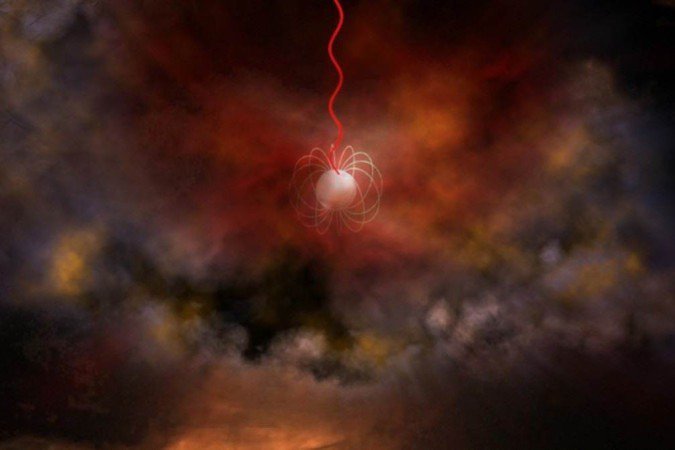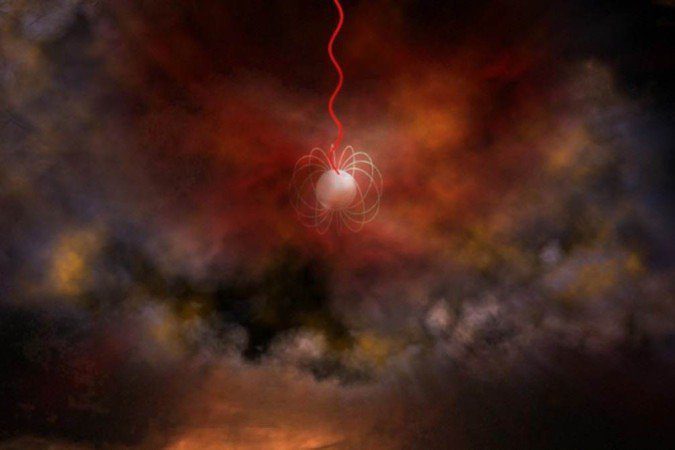
Posted on 08/06/2022 21:28 / Updated on 08/06/2022 21:36
(credit: Bill Saxton, NRAO/AUI/NSF)
Astronomers have found the second instance of a Fast Radio Burst (FRB) in history. The incident raises questions about the nature of the mysterious space phenomenon. The explosions are intense and occur through brief flashes of radio frequency emission, lasting milliseconds.
This phenomenon was first discovered in 2007 by graduate student David Narkevic and is commonly known as the ‘Lorimer Burst’. The source of these high-energy events is a mystery, but clues to their nature are being collected through repetition.
FRB is a transient radio pulse that varies in length by a fraction of a millisecond Milliseconds away, due to some mysterious high-energy astronomical process that has yet to be discovered. Astronomers estimate that the average FRB releases the same amount of energy in one millisecond (one-thousandth of a second) as the Sun does in 3 days (which equals about 250,000 seconds).
The new discovery raises new questions about the nature of these mysterious objects and their usefulness as tools to study the nature of intergalactic space.
The new source was detected in 2019 with the Five-hundred-meter Aperture Spherical Radio Telescope (FAST) in Guizhou, China. The discovery was observed in 2020 by the Jansky Very Large Array (VLA) program. Led by Caltech, the group was able to pinpoint the location of the object, and this allowed visible-light observations with the Subaru telescope in Hawaii to show that it was on the outer side of a dwarf galaxy about 3 billion light-years from Earth. is in the area.
VLA observations also found that the object emitted weak radio waves between successive bursts.
For the National Astronomical Observatories of China (NAOC), Di Li, leader of the Commons Radio Astronomy Fast Survey (CRAFT) that discovered FRBs in China, highlights that the biggest question is where the explosions come from. “One of the major questions in the field of FRBs is whether or not all sources repeat themselves.”
The researchers point out that another distinguishing feature is the wave dispersion measurement, which indicates that the emission has passed through the highest electron density of any FRB before being observed on Earth. This suggests that the FRB is active in a local plasma environment, such as that created by a supernova, and is a newly created source.
While providing insight into the environment of FRBs, the wide disparity in scatter measurements with other FRBs calls into question their use as “cosmological standards” for measuring distances.
Franz Kirsten, a postdoctoral researcher at the Dutch Institute for Radio Astronomy (ASTRON), told space.com That it would be possible to trace an evolutionary path to rapid radio bursts, but with only these two sources it is difficult to say. “We need to find more and disrupt this evolutionary stage model. We really need more[radio bursts]at different ages, okay to say, this thing is disappearing all the time So it would be really cool to see if these persistent sources were actually disappearing over time”
Co-author Yu Wenfei pointed out space.com Yu said, “The mechanism responsible for additional scatter measurements of such repeated FRBs with PRS association and the quasi-source environment is still a problem. But I am optimistic that investigating such extreme FRBs will solve the FRB puzzle.” It will happen.”
This is why there is high value in searching for more frequent FRB sources, as well as trying to get a better picture of the atmosphere, for example using the Hubble Space Telescope for follow-up observations.
*Interns under the supervision of Pedro Grigori.





